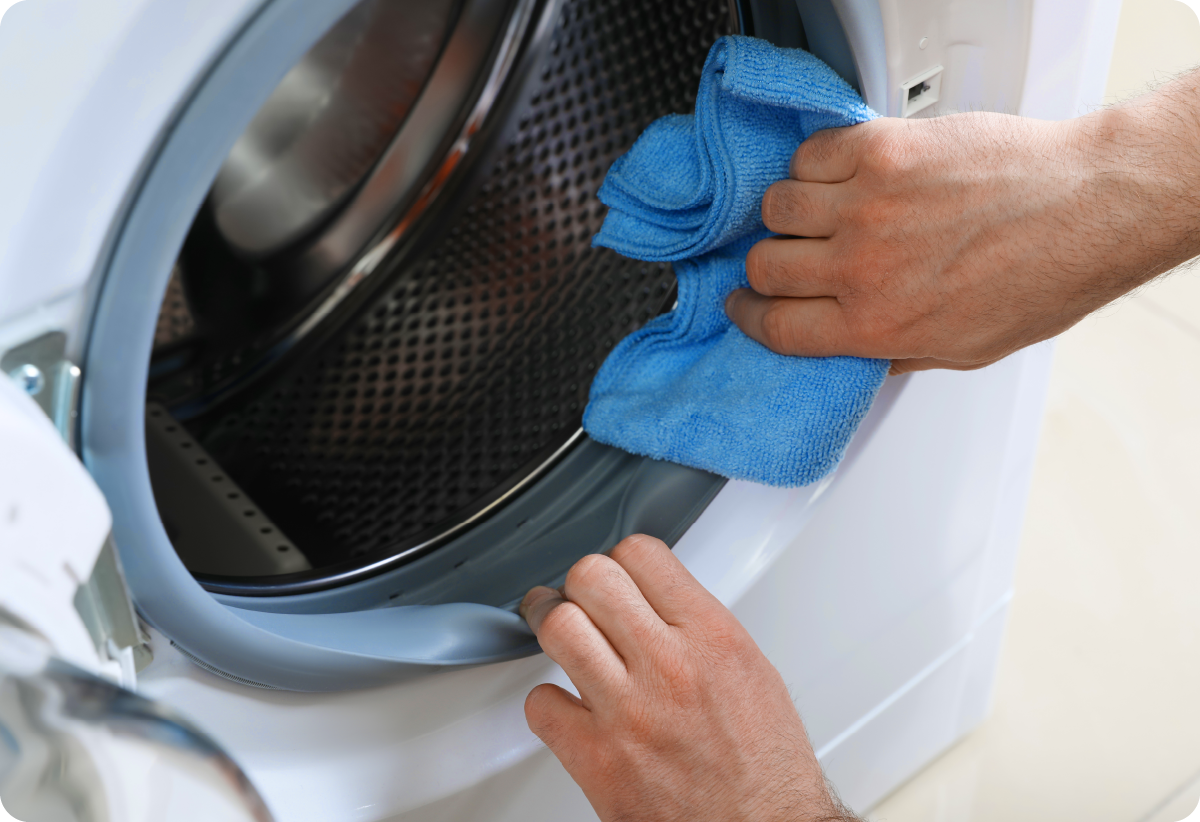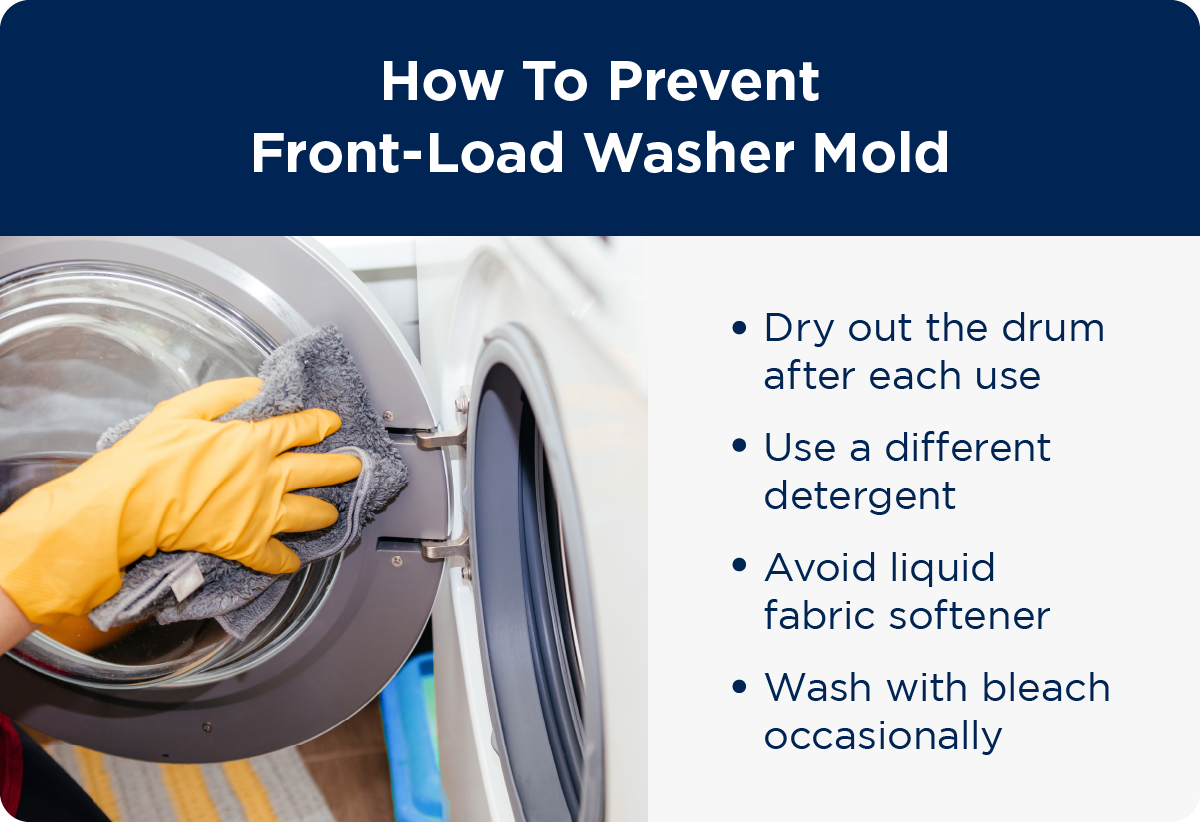How To Clean Front-Load Washer Mold

Front-load washer mold can be cleaned using a variety of methods, including bleach, mildew remover, vinegar, or baking soda. The best method is prevention, which means allowing your washer to dry out completely between washes and sanitizing it regularly.
While front-load washers may be all the rage, their design makes them more prone to mold. If you have one, you need to know how to clean front-load washer mold and mildew because it’s not just a possibility —it’s inevitable.
We’ll explain how to clean front-load washer mold and some of the best ways to prevent it.
Tools for Cleaning a Front Load Washer
There are several ways to clean front-load washer mold, each of which will require different tools and cleaners. Many of the materials you need are household items you likely already have on hand:
- Cleaning rag
- Mildew cleaner
- Dish soap
- Bristled cleaning brush
- Vinegar
- Baking soda
- Bleach
- Gloves
- Paper towels
- Toothbrush
1. Clean the Gasket
The gasket is the outer rubber ring of a washing machine located directly inside the door. It prevents water from leaking outside the washer and is the area most prone to developing mold.
You can effectively clean the gasket of your washing machine in several ways, so put on some gloves and try one of these methods:
- Spray a rag with mildew cleaner and wipe the gasket, being sure to reach down behind it as well.
- Using a clean bristled cleaning brush, scrub around the gasket with your preferred cleaning solution. You can use a bleach solution, vinegar, a mildew cleaner, or baking soda. Do not mix cleaning products, and be sure to clean the gasket and surrounding areas with water and wipe off any remaining solution.
- Cover the entire gasket in paper towels and then spray with bleach. Allow to sit for 5-10 minutes, then remove and run an empty rinse cycle. The paper ensures the bleach stays on the entire gasket rather than pooling at the bottom.
Quick tip: Be sure to clean under the gasket seal as well, as water tends to sit in this area and develop mold and mildew.

2. Clean the Dispensers
The detergent and fabric softener dispensers build up residue over time, inviting mold and odors to form. As part of regular upkeep, consider cleaning the dispenser in your washer every month or two.
To clean the dispensers, remove them from the washing machine and scrub them with soap and water. If they don’t slide out completely, wipe them as thoroughly as possible.
3. Clean the Washer Door
When cleaning the gasket, you should also clean the washer door. Using a similar method to clean the gasket. Scrub down the door with a cloth and mildew cleaner, bleach, or vinegar. Wipe it clean with water and then leave the door open to dry.
Be sure to clean along the edges where the door seals to the washer, as this is a hot spot for mold to develop. Using an old toothbrush will allow you to get in the grooves along the door.
4. Run a Sanitize Cycle
When figuring out how to clean front load washer mold, cleaning the inside of your washing machine can be the best place to start. Many washing machines have a sanitize cycle — an empty wash cycle designed to clean the drum and kill mold and germs with high water temperatures.
Check the settings on your machine and look for the sanitize cycle. Add one of the following to boost the effectiveness of the cycle: a cup of bleach, a cup of baking soda, a cup of vinegar, or one residue-busting washer pellet. Repeat as often as once a month for the best results.
How To Prevent Mold in a Washing Machine
Front-load washers require more regular maintenance than top-load machines. Fortunately, a bit of prevention is usually enough to keep mold growth at bay.

Take these preventative steps to keep mold from developing in your front-load washer:
- Dry out the drum after each use: The front-load door should have the option to sit ajar without hanging open. Keep your washer in this position when it’s not in use. To help the drum dry out, remove clothing promptly and wipe down the gasket after each cycle.
- Use a different detergent: Front-load washers are considered high-efficiency (HE) machines, so choose detergent with the HE designation to keep the suds down. Also, use less detergent to reduce residue buildup.
- Avoid liquid fabric softener: To keep mold-attracting residue to a minimum, ditch the fabric softener. Instead, keep your clothes soft with dryer sheets or dryer balls when you run them through the dryer.
- Wash with bleach occasionally: Once a month, run a hot water cycle with bleach. This can be an empty load, or you can throw in sturdy work towels, white linens or clothing, outdoor fabrics, or muddy gardening clothes.
Why Front-Load Washers Are Prone to Mold
To keep the water and detergent that sloshes up against the door from leaking, these washers feature a watertight seal to prevent leaks. However, the rubber gasket used to achieve this seal also provides the perfect hiding place for mold and mildew.
Conversely, top-load washers feature a loose-fitting metal door that doesn’t seal tightly when you close it. As a result, the drum can dry out quickly between loads, which is the primary reason why mold isn’t as prevalent in top-load washing machines.
The most commonly used laundry liquids don’t help, either. Soapy suds and liquid fabric softener leave film and residue behind that invite mold colonies to form. Once established, energy-saving cold water cycles and eco-friendly detergent aren’t enough to blast through and remove the mold.

FAQ About How To Clean Front-Load Washer Mold
Knowing how to clean front load washer mold is important to ensure the longevity of your washing machine and get the best performance out of the appliance.
Here are some frequently asked questions about mold in front-load washing machines.
How Do You Get Mold Out of a Washing Machine?
You can clean mold out of a washing machine by using a cloth and some bleach, vinegar, mildew remover, or baking soda. You can also use a bristled cleaning brush to scrub the mold. Some newer front-load washers also have a setting for sanitizing, which is great for killing germs and mold colonies.
How Do You Get Black Mold Out of Washing Machine Rubber?
Using gloves and protective eyewear, clean the area with a bleach or vinegar solution. Remember, never mix cleaning solutions, especially bleach, and vinegar as this creates a dangerous gas. Allow the solution to sit on the mold for approximately 30 minutes before wiping it clean with water and allowing it to dry fully. Do not let
Is My Washing Machine Ruined if It Has Mold in It?
No, your washing machine is not ruined. You can clean and remove the mold safely using a bleach or vinegar solution, paying particular attention to the door seal. If you’re worried your machine is beyond fixing, contact an appliance repair professional for an assessment.
Schedule Washer and Dryer Repair
Front-load washers offer several advantages, but proper care and maintenance are needed to keep mold out of your washer and away from your clean clothes. While a moldy washer will not prevent you from using it, you still need to know how to clean a front-load washer that has mold, to ensure your machine continues to operate properly. Failing to do so can lead to other problems that will prevent you from washing your clothes at all!
When this happens, contact your local Mr. Appliance® for all your washer and dryer repair needs. Our team of local appliance pros is equipped with the parts and expertise needed to get your machine working again quickly. To schedule service and repair, please contact us today.
 Click to call
Click to call


